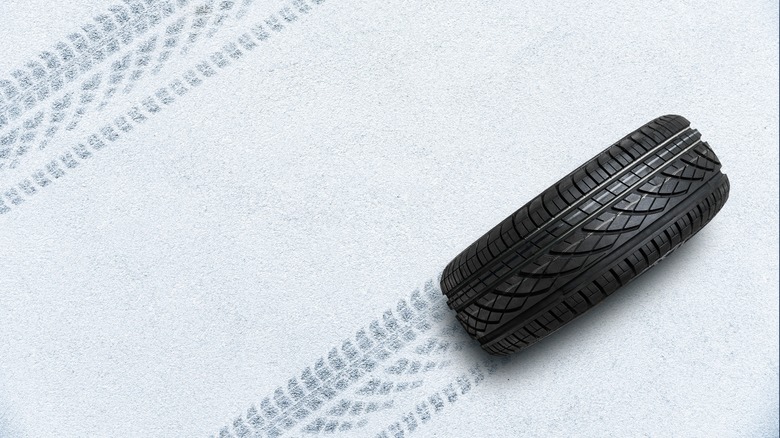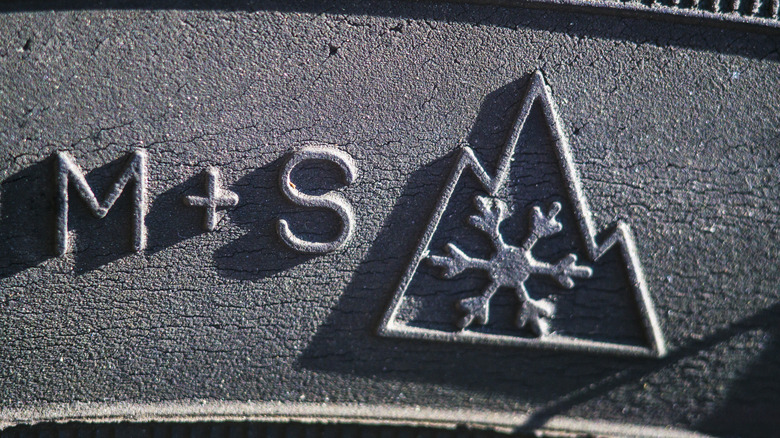What Does The Mountain Symbol On Certain Tires Mean And Which Types Come With It?
Normally, the only markings you see on your tire's sidewall are letters and numbers. There's the SSR label that means the tire can run flat for a limited distance, 225/45R18 that points to your tire size, and 3815 next to the letters DOT that represents your tire's week and year of manufacture.
But on some other tires, particularly on high-rated snow tire brands, there's an extra marking that isn't a letter or a number but a pictograph. It's a mountain symbol with three peaks and a six-sided snowflake inside, typically seen close to the tire size labels. By just looking at this icon, you could probably guess it's for winter use, and you're right. The mountain symbol, formally called Three-Peak Mountain Snowflake, or 3PMSF for short, means that your tire is rated for driving in low-temperature locations. But exactly what conditions can this kind of tire withstand and how is it different from the M+S label?
The tire mountain symbol, explained
The Three-Peak Mountain Snowflake symbol, also known as the Alpine symbol, is an indication that the tire is certified as a winter tire in the US, Canada, and across Europe. It passed through the ASTM F1805 tire test, a standardized test to check if a tire can perform well when driven on medium-packed snow-covered surfaces. That being said, the 3PMSF is essentially a guarantee that you can safely drive such tires even on roads with severe snow, like in ski resorts. Compared to non-3PMSF tires, they should provide enough traction to give you better control of your car. Normally, this marking can appear on all-weather tires and some all-terrain and all-season tires.
If you're going to use the tires for winter, the 3PMSF symbol isn't the only thing you should check. Take your time to measure your tire tread depth, too, and make sure it's still at 4 mm or more. A tread depth below 4 mm would be risky to drive on, as its traction performance on snow wouldn't be as reliable.
If you're buying a brand-new snow tire instead, see if it comes with the Ice Grip logo on top of the 3PMSF icon. The Ice Grip logo looks like a single-peak mountain with an icy top. Like the 3PMSF, it's also a tire standard with regulatory testing, but the tire test measures ice braking and not simple snow driving. This means the tires with Ice Grip are suitable for driving and braking on icy surfaces. Since it's a fairly new standard, though, you might not see it on many tires yet.
M+S versus 3PMSF
When it comes to winter tires, you'll usually see two types of sidewall markings: M+S and 3PMSF. Both symbols do tell you that a tire is winter-ready, but they don't exactly mean the same thing. M+S, which can also show up as M&S, M/S, MS, or M-S, means Mud and Snow. Unlike your regular tires, M+S tires are designed with a specific tread pattern or structure to handle both muddy and snowy roads.
However, they didn't undergo certified testing. The marking is only assigned because of the tire's tread and not because it passed a standard test. They're simply rated by the manufacturers themselves. While these tires are still technically engineered for use on snow (not severe, though), the M+S label is more like a distinction than a certification. It was only added to the tire's sidewall as a way to set it apart from the regular non-snow tires.
The 3PMSF tires, on the other hand, are considered the true and legal winter tires. They're known to have passed or even exceeded the minimum testing requirements to earn the marking in the first place. Most of the time, you'll see both the M+S and mountain symbols together on a tire's sidewall. That just means it's capable of driving through both muddy and severe snow conditions. But if your tire only has the M+S logo and not the 3PMSF, manufacturers recommend switching to tires with the Alpine symbol as soon as you can. Regularly using just M+S rating tires on severe snowy roads is one of the bad habits that can degrade your tires.


